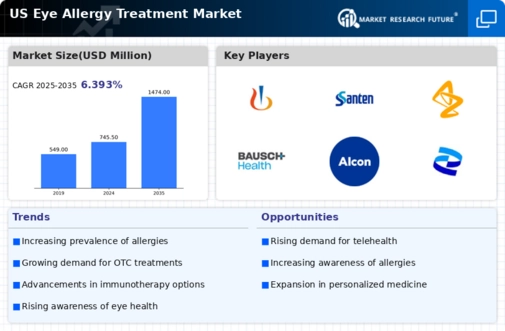Growing Awareness of Eye Health
There is a notable increase in public awareness regarding eye health, which is positively influencing the eye allergy-treatment market. Educational campaigns and initiatives by health organizations are informing individuals about the importance of managing eye allergies effectively. This heightened awareness is likely to lead to more people seeking treatment for their symptoms, thereby driving market growth. The eye allergy-treatment market is benefiting from this trend as consumers become more proactive in addressing their eye health. Furthermore, the rise of social media and online health resources has made information more accessible, encouraging individuals to consult healthcare professionals for their eye allergy concerns. As awareness continues to grow, the demand for effective treatments is expected to rise, further propelling the market forward.
Impact of Environmental Factors
Environmental factors are significantly influencing the eye allergy-treatment market. The rise in air pollution and climate change has been linked to an increase in allergens such as pollen and mold, exacerbating allergy symptoms for many individuals. As these environmental triggers become more prevalent, the demand for effective eye allergy treatments is likely to rise. The eye allergy-treatment market is responding to this challenge by developing new products that address these specific environmental concerns. Furthermore, public health initiatives aimed at reducing pollution and improving air quality may also impact the market, as they could lead to a decrease in allergy cases over time. However, until such improvements are realized, the market is expected to continue growing in response to the ongoing challenges posed by environmental factors.
Increasing Prevalence of Allergies
The eye allergy-treatment market is experiencing growth due to the rising prevalence of allergies among the population. According to the Centers for Disease Control and Prevention (CDC), approximately 19.2 million adults in the US have been diagnosed with hay fever, a common cause of eye allergies. This increasing incidence is likely to drive demand for effective treatment options. As more individuals seek relief from symptoms such as itching, redness, and swelling, the market for eye allergy treatments is expected to expand. Furthermore, the growing awareness of allergy management and the availability of various treatment modalities, including antihistamines and corticosteroids, contribute to the market's growth. The eye allergy-treatment market is thus positioned to benefit from this upward trend in allergy cases, leading to increased sales and innovation in treatment options.
Expansion of Retail Pharmacy Services
The expansion of retail pharmacy services is playing a crucial role in the eye allergy-treatment market. Many pharmacies are now offering a wider range of allergy medications, including over-the-counter options, making it easier for consumers to access treatments. This trend is particularly relevant as more individuals prefer the convenience of purchasing medications without a prescription. The eye allergy-treatment market is likely to benefit from this shift, as increased availability can lead to higher sales volumes. Additionally, pharmacies are increasingly providing consultation services, allowing patients to receive personalized recommendations for their eye allergy treatments. This enhanced accessibility and support from retail pharmacies may contribute to a greater number of individuals seeking treatment, thereby driving market growth.
Advancements in Pharmaceutical Research
Innovations in pharmaceutical research are significantly impacting the eye allergy-treatment market. The development of new and more effective medications, including biologics and targeted therapies, is enhancing treatment options for patients. For instance, recent advancements have led to the introduction of monoclonal antibodies that specifically target allergic responses, providing relief for patients who do not respond to traditional treatments. The eye allergy-treatment market is likely to see a surge in demand as these novel therapies become available. Additionally, ongoing research into the underlying mechanisms of allergic reactions may lead to the discovery of new therapeutic targets, further expanding the market. As pharmaceutical companies invest in research and development, the potential for breakthrough treatments could reshape the landscape of the eye allergy-treatment market.




















Leave a Comment